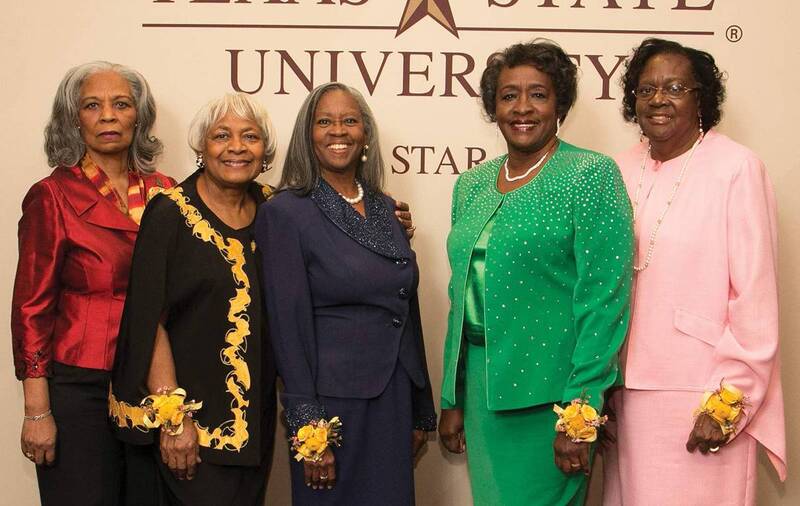First Five: The Women Who Integrated the College
First Five Freedom Hall is named for Dana Jean Smith, Georgia Faye Hoodye, Gloria Odoms, Mabeleen Washington, and Helen Jackson, the first Black students at Southwest Texas State College (now Texas State).
Until justice is blind, until education is unaware of race, until opportunity is unconcerned with the color of men’s skins, emancipation will be a proclamation but not a fact.
– Vice President Lyndon Baines Johnson, 1963
Left: Portrait of four of the first five Black women to enroll at SWT, Registrar’s Office, February 4, 1963. Standing: Georgia Hoodye, Mabeleen Washington. Seated: Dana Smith, Gloria Odoms. Helen Jackson enrolled the following day.
The Story of Integration at Texas State
When the Southwest Texas State Normal School (now Texas State) was authorized by the Texas Legislature in 1901, the General Laws of Texas stipulated that the "rules and regulations provided by law for the government of the Sam Houston Normal Institute shall apply in all respects so far as applicable to the government and control of the Southwest Texas [State] Normal School." As spelled out in the 1925 Civil Statutes of the State of Texas Article 2644: State teachers colleges were "for the training of white teachers."
In the summer of 1962, Dana Jean Smith, an 18-year-old Black woman, applied for admission to what was then called Southwest Texas State College. A graduate of Austin’s Anderson High School, Smith was academically qualified to enroll in the college. President John G. Flowers, in a letter dated June 22, 1962, said Smith’s application was rejected because of the whites-only provision in the charter establishing the college. He also informed her that only an act of the state Legislature or a court order would make it possible for Smith and other Black students to be admitted.
A similar letter was sent to another young Black woman who applied, Mabeleen Washington Wozniak. “We had met all the requirements, but 'we were of the Negro race,’” she said. “I wanted to go to college really, really bad. My dad told me he wouldn’t pay for college out of town.”
Dana Smith filed a complaint against the college, alleging that the college’s whites only admissions policy abrogated rights granted to her under the United States Constitution. In August 1962, Attorney [J. Phillip] Crawford filed suit number 1305 in U.S. District Court in Austin, Texas.
At approximately 2:30 p.m. on Monday, February 4, 1963, U.S. District Judge Benjamin Herbert Rice Jr. signed the court order that ended segregation at SWT. His order instructed the college to “forthwith admit and enroll the said plaintiff, Dana Jean Smith, to said Southwest Texas State College, and to the utilization and participation in all of the education facilities...on the same basis as all others entitled thereto.” By 3:15 that afternoon, Miss Smith and three other Black women from San Marcos, Georgia Faye Hoodye, Gloria Odoms, and Mabeleen Washington, registered for classes assisted by the registrar, Clem Jones. On Tuesday, Helen Jackson, another Black student enrolled. Because the court order was not issued until after regular registration had been completed, the women enrolled in the registrar’s office.
President Flowers was correct when he predicted that the school would “obey the court order and provide a model of peaceful integration as Negroes begin classes for the first time in its 60-yearhistory.” However, Dr. Flowers could not shield the women from occasional racial slurs and covert instances of discrimination. Undeterred by the challenges that a trailblazer often encounters, Miss Smith persevered, and she was awarded a Bachelor of Science degree in elementary education in 1967.
Sources: The African-American Presence at SWT: Celebrating Forty Years; Naming Task Force Announcement, May 2021
A New Name for a Residence Hall
On May 20, 2021, The Texas State University System Board of Regents approved the motions set forth by Texas State University to rename two residence halls that were originally named for rivers – Angelina and San Gabriel on the San Marcos Campus – and name two unnamed streets on the Round Rock Campus after distinguished members of the Texas State family who are from the Black and Hispanic/Latinx communities.
Angelina Hall will be renamed to First Five Freedom Hall, after Dana Jean Smith, Helen Jackson Franks, Georgia Hoodye Cheatham, Gloria Odoms Powell, and Mabeleen Washington Wozniak, who were the first Black students at Texas State in 1963.
The First Five as Individuals
While recognized as a group in the naming of the residence hall, each woman had a unique experience and her own perspective. Individually, they have been active at the local and statewide level, contributing time and talents to various non-profits. The following pages are dedicated to each of the "First Five."
Left: Portrait of the first five Black women to enroll at SWT returning to campus in 2021. Standing: Dana Jean Smith, Helen Jackson Franks, Georgia Hoodye Cheatham, Gloria Odoms Powell, and Mabeleen Washington.


